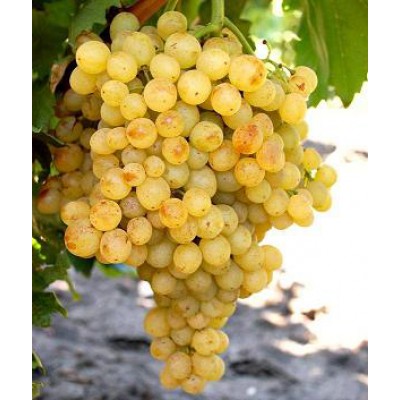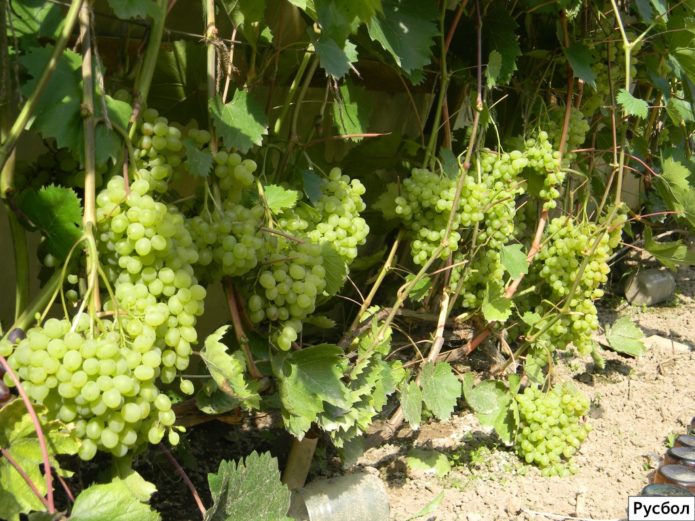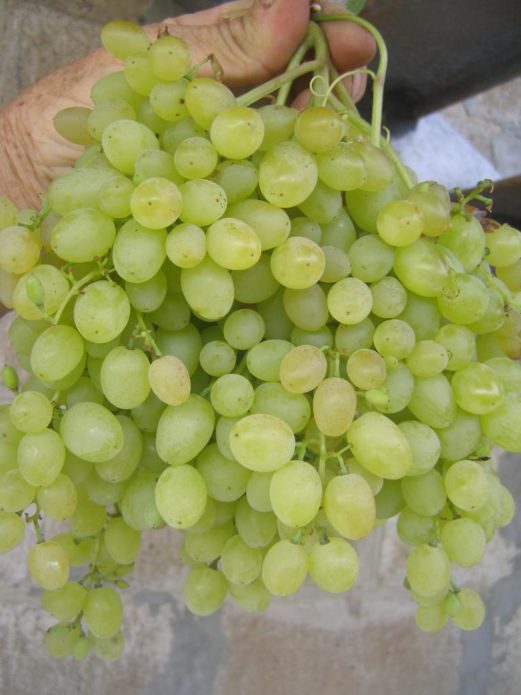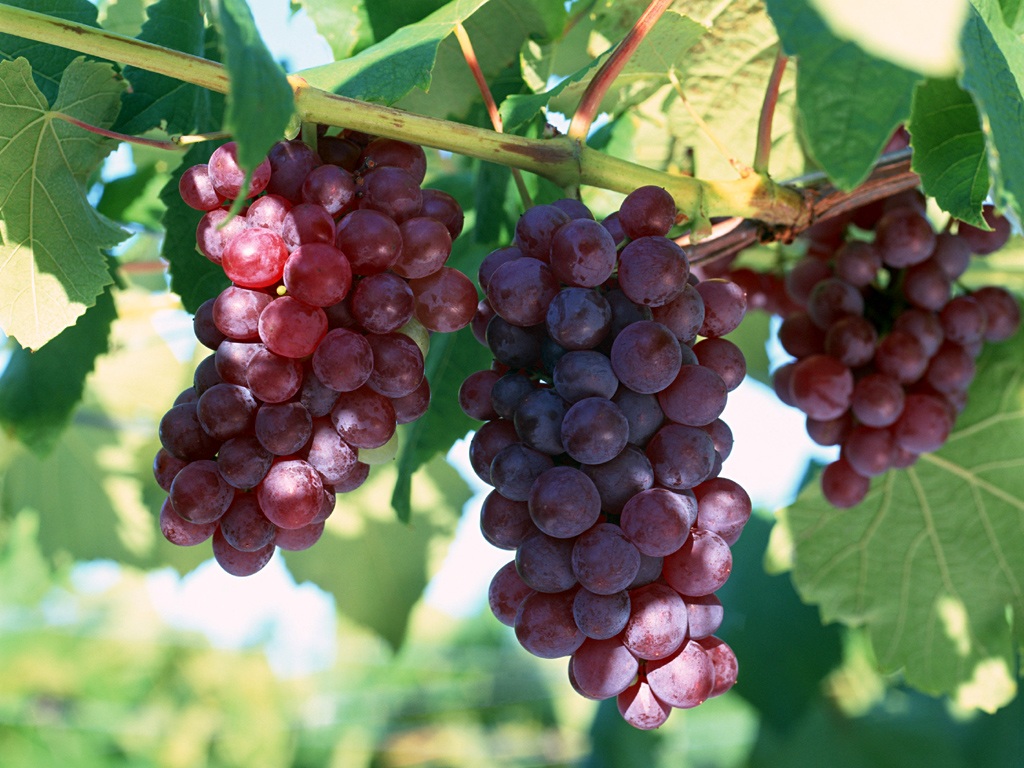All grape varieties are divided into dining and technical, but the group of raisins stands apart, which are ideal for making raisins: they have absolutely or almost no seeds at all. One of these varieties is the Rusbol grape, also known as the raisin Mirage - grapes with a long history, but still popular.
Content
Breeding history, description and characteristics of the Rusbol grape variety
The Rusbol grape is a Soviet-Bulgarian variety created as a result of cooperation between two institutes: NIIViV (Bulgaria) and VNIIViV named after Ya. I. Potapenko (Novocherkassk). It is easy to understand that its name comes from the names of two countries. This favorite of Russian summer residents was obtained as a result of selection based on the varieties Villar Blanc and Superearly seedless.
Rusbol ripens relatively early, 115-125 days pass from budding to harvest readiness. It is a table variety with soft seeds, the so-called rudiments, but they are not very small in size and weigh up to 60 mg. As a result, the variety belongs only to the IV class of seedlessness.
The bush of this grape is medium in size at first, but after a few years the vigor of growth increases. The variety propagates very easily by cuttings and is compatible with most widely used rootstocks. Experts advise grafting Rusbol on vigorous bushes. Young shoots ripen to their full length, and ripening ends long before the end of warm days, the bush has time to prepare well for winter. You can prune the vine according to any convenient scheme.
In the absence of plant care, its fruits become small and sour. Such a vine is called "neglected" or "run wild", and one does not expect a good harvest from it. Timely pruning of the bush will prevent all these troubles:https://flowers.bigbadmole.com/en/uhod-za-rasteniyami/obrezka-vinograda-vesnoy.html
Flowers are bisexual, pollinators are not required for Rusbol. Moreover, it is itself an excellent pollinator for many other varieties, as it blooms for a long time, abundantly and annually. Own-rooted shrubs begin to bear fruit in the second year after planting. Its yield is very large: the variety is even called suicide, because under the weight of its own harvest, the vines can break without proper care. The rationing of the crop is strictly mandatory. All underdeveloped shoots are also removed so that the forces are redistributed to fertile vines.
Its frost resistance is slightly higher than that of most modern varieties: bushes without shelter can withstand frosts down to -25 aboutC, in many regions, the variety is considered non-covering. It is moderately resistant to most diseases.
Bunches are densely or medium densely packed with berries, the usual weight of a bunch is about 500 g, specimens up to 1.0-1.5 kg are not uncommon. The shape of the bunch is conical. The variety cannot be called transportable, it is grown for local consumption.The removed clusters are well stored, but more often they are immediately processed into raisins.
Berries are oval, not very large, weighing only 3-4 g, amber-yellow color. The berries have a simple taste, they are quite suitable for direct consumption, but not very good fresh, the main purpose of the harvest is raisins. Tasters rate fresh berries at 7.6 points, raisins at 7.8. The sugar content is about 20%, the acidity of the juice is 5–8 g / l. The skin is thin, the rudiments do not interfere with the use of berries, but give the raisins a peculiarity. Unfortunately, in rainy weather, the berries are prone to cracking.
Features of planting and growing grape varieties Rusbol
Rusbol is an unproblematic variety in terms of planting and cultivation, it does not cause much trouble even for a novice winegrower. It is unlikely that such an owner will plant this variety on other bushes, most likely he will buy a ready-made seedling. When buying, you need to pay special attention to the root system, and only then to everything else. Both the roots and the shoot should be elastic, and the buds should be large and dense.
The more roots the better. Make sure the roots are alive: if you pinch off a piece of root with a knife, the cut of a quality plant will be white and damp. If the cut is dark or dry, then the seedling died:https://flowers.bigbadmole.com/en/yagody/vinograd/kak-posadit-vinograd-vesnoy-sazhentsami.html
Planting Rusbol grapes is possible both in autumn and spring, but in the middle lane it is better to do this in April. Planting does not differ from planting other grape varieties: the place is chosen sunny and protected from cold winds, a planting pit is prepared in advance. On clay soils, a hole has to be dug in sizes from 80 x 80 x 80 cm, on sandy soils it can be smaller. If planting is carried out near buildings, at least one and a half meters must be retreated from the foundation. When planting several bushes, do not part: the minimum distance between them is 2 meters.
At the bottom of the pit, a drainage layer (10–15 cm) of rubble or any similar material must be placed. Above is a layer of fertilizer mixed with the soil, and then a layer of pure fertile soil. Fertilizers are 1.5–2 buckets of humus, a liter can of ash and 300–400 g of any complete mineral fertilizer. When planting, they try to do so that the roots of the seedling do not come into contact with fertilizers. Two buds are left on the surface. A strong stake is immediately driven in to tie the growing shoot, but it is better to design a strong trellis in advance for the future. After planting, the bush is well watered, the soil must be mulched. In the first year, it is necessary to water the grapes often so that the soil does not dry out for a day.

A thick pipe is often drawn into the pit so that irrigation water flows directly to the roots of a young seedling
Adult bushes are watered two to three times a month, the amount of water required depends on the weather. It should not be watered only during flowering and during the ripening period. When planting, it is most convenient to provide for the arrangement of a vertical irrigation pipe, leading it directly to the drainage layer, but on sandy soils, you can water in the usual way. It is advisable that the water be heated in the sun. Excessive waterlogging is unacceptable: it is better for the soil to dry out slightly than there will be stagnation of water: adult grapes will find themselves the minimum required amount of moisture. We also need podzimny watering, after the foliage has fallen.
The grapes are fed with both organics and mineral fertilizers. Compost or rotted manure is applied every two or three years (in early spring, two buckets are sealed in small holes), full mineral fertilizers can be given according to instructions in the first half of summer, and as the berries grow, nitrogen fertilizers are excluded. Mineral fertilizers are very useful in the form of foliar dressing: by spraying the foliage shortly before flowering and immediately after it. And, at any time of the year, you can give the grapes wood ash, scattering it around the bush before watering.
Fungal diseases can cause big problems, so you should not neglect the preventive treatment of the bushes with fungicides. There are many preparations available for this purpose, but most winegrowers use the most traditional ones. In early spring, the bushes are treated with iron vitriol, along a green cone with Bordeaux liquid, and in the phase of several leaves - with Horus or Ridomil Gold preparations.
The first spring treatment of grapes from diseases: https://flowers.bigbadmole.com/en/yagody/vinograd/chem-obrabotat-vinograd-vesnoy-posle-otkryitiya.html
Rusball lays a huge number of bunches that cannot be pulled out. At the same time, he has no more than 15% of infertile shoots. When growing these grapes, rationing of the crop and careful cutting of unnecessary shoots are vital. In early spring, only obviously unusable vines are cut out, the rest of the work on forming the bushes begins immediately after flowering and continues until winter.
It is known that about 20 full-fledged leaves should fall on one average bunch, which is sometimes used by growers to estimate the amount of harvest left.
As soon as flowers appear, it will be possible to break off those shoots on which flowers have not formed. In summer, pruning shears are almost not required: all green operations on grapes are easily carried out with bare hands. After the end of flowering, they approach the bush again and break out all the small clusters. And even the remaining bunches are "trimmed", doing it in the manner of a hairdresser who trims the hair.

Rusball is also capable of giving out this: of course, a fair amount of nascent berries will have to be removed as soon as possible
The main pruning occurs in autumn, when the bush is finally formed. Since Rusbol's eyes are fruitful almost along the entire length of the vine, prune grapes correctly in autumn for any length. It happens that only 2-3 eyes are left on the shoots, but more often - from 6 to 8. Experts still advise to leave short shoots, they are enough to get a good harvest. In total, 35–45 eyes can be left on an adult bush.
In the southern regions, Rusbol is not even removed from the trellises for the winter; in the middle lane, an easy shelter is desirable. After removing the vines from the trellises, they are wrapped in non-woven materials or spruce branches of coniferous trees are thrown on them. In principle, if you hope that the snow will fall on time, you can even not do this, but only bend the vines to the ground. But year after year is not necessary! Although it is known that if the kidneys are partially damaged by frost, Rusbol fully recovers over time due to sleeping eyes. The grapes are opened in the spring with the arrival of warm weather.
Video: Rusball in Belarus
Advantages and disadvantages of the variety in comparison with similar
It cannot be said that Rusbol is among the best among the raisins. It has rather small berries, and the presence of large rudiments in them assigns the variety only to the IV class of seedlessness. And the tasting marks are not the highest. But, for example, in comparison with the Century raisin, which bears fruit with large berries without seed germs, Rusbol is much easier to care for, which makes it possible to recommend it even to the most inexperienced summer resident. The most important advantages of the variety include:
- stable huge yields;
- high frost resistance, the ability to self-recover after extreme cold weather;
- unpretentiousness to growing conditions;
- the ability to use any formation of bushes, convenient for the owner;
- bisexual flowers, excellent pollinating ability in relation to other varieties;
- intactness of berries by wasps;
- early ripening.
The experts consider the disadvantages:
- cracking berries in rainy weather;
- low transportability of the crop;
- the need for serious rationing of the crop.
Kishmish Rusbol, despite the noted shortcomings, is so easy to care for and harvest that it can become the pride of any vineyard, even against the background of many new products.
Variety reviews
If I was asked what variety with minimal care is capable of producing a high yield, then I undoubtedly answered - RUSBOL, this is it. A very productive variety, seedless, harmonious taste, and children love it as they like. Now it blooms, what a strong smell it has, it's not for nothing that it is a pollinator. True, from the whole district attracts bronze women, I have already counted fifty, but these are trifles. In general, a worthy variety for a gardener inexperienced in the intricacies of viticulture. I recommend.
She planted Rusbol as a pollinator for the female team. Several signals this year. The taste was pleasantly surprised, the bones, of course, are large for such a berry ...
I have three fruiting Rusbol bushes. Very robust and stable variety. One of the first to bloom - very beautiful inflorescences. Pollinated without problems. Tried growing with both long and short pruning. With a short groove, you get larger (1.0–1.3 kg) and the berries in the groove are larger. In the pea stage, it is advisable to try to arrange each gron separately. Growing groves often get tangled together, which causes shedding of berries when picked. I remove the ends of the heads, since they are often sparse. I did not notice any illnesses on Rusbol. There was no cod of berries, wasps did not hurt. When the crop was overexposed, a partial shedding of berries was noticed on the bush. The berries contain soft rudiments of seeds. The vine ripens early and for the entire length of the growth. Given the early ripening period and good frost resistance, Rusbol can be grown, probably, in more northern regions.
You can summarize the past season. Rusbol, as always, did not disappoint. It bloomed on June 7, after strict rationing, 35 bunches were left - almost all large. After August 10, they already began to try, but the sourness was still felt. They began to cut off in bunches after August 20. But then gray rot began to appear and on August 27 they removed 7 kg at once, and on September 3 everything else. The main part went to wine, mixed with the remnants of Rusven and Elegy. The wine, I must say, turned out well. The growth of Rusbol, despite the significant load, was very good, the vine also matured remarkably - by 15-17 eyes, which is a record for Rusbol (usually by 6-8 hl).
Video: all about Rusbol grapes
Kishmish Rusbol, aka Mirage, is an old proven grape variety that has a lot of advantages and is available for growing to beginners. This grape is often planted even in Siberia, getting decent yields of delicious berries, from which raisins are mainly prepared. Rusbol is especially attractive on private households, as it is intended for quick processing, it is almost never grown for sale.





